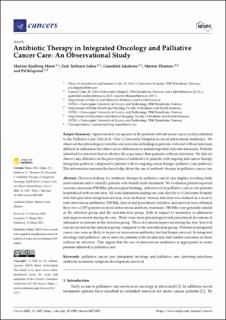| dc.description.abstract | Simple Summary
Approximately one-quarter of the patients with advanced cancer acutely admitted to the Palliative Care Unit at St. Olav’s University Hospital received intravenous antibiotics. We observed that physiological variables and paraclinical findings in patients with and without infections differed at admission but observed no differences in patient-reported outcome measures. Patients admitted for infection had no shorter life expectancy than patients without infections. We did not observe any difference in the prescription of antibiotics to patients with ongoing anti-cancer therapy (integrated pathway) compared to patients with no ongoing cancer therapy (palliative care pathway). This information increases the knowledge about the use of antibiotic therapy in palliative cancer care.
Abstract
Decision-making for antibiotic therapy in palliative cancer care implies avoiding futile interventions and to identify patients who benefit from treatment. We evaluated patient-reported outcome-measures (PROMs), physiological findings, and survival in palliative cancer care patients hospitalized with an infection. All acute admissions during one year, directly to a University Hospital unit that provided integrated services, were included. Serious infection was defined as a need to start intravenous antibiotics. PROMs, clinical and paraclinical variables, and survival were obtained. Sixty-two of 257 patients received intravenous antibiotic treatment. PROMs were generally similar in the infection group and the non-infection group, both in respect to intensities at admission and improvements during the stay. There were more physiological and paraclinical deviations at admission in patients in the infection group. These deviations improved during the stay. Survival was not poorer in the infection group compared to the non-infection group. Patients in integrated cancer care were as likely to be put on intravenous antibiotics but had longer survival. In integrated oncology and palliative cancer services, patients with an infection had similar outcomes as those without an infection. This argues that the use of intravenous antibiotics is appropriate in many patients admitted to palliative care. | en_US |

